LodraniteRare type of primitive achondrite named after the Lodran meteorite that fell in Pakistan in 1868. Initially, lodranites were grouped with the stony-iron meteorites because they contain silicates (olivine, orthopyroxene, and minor plagioclase) and Fe-Ni metal in nearly equal proportions. However, since discovery of the closely related acapulcoite group, lodranites Click on Term to Read More
anomalous, metal-rich
(previously classified as Iron, IAB complex, NWA 468 duo)
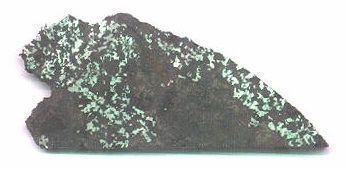
Purchased before January, 2000
no coordinates recorded A relatively fresh (W1) silicated iron meteoriteIron meteorites consist mostly of metallic iron alloyed with typically between ~5 to ~30 wt% nickel. The main metal phases are kamacite α-(Fe, Ni) and taenite y-(Fe, Ni). Based on their group classification, they may also contain a small weight percentage of one or more of the following minerals: • Click on Term to Read More weighing 6,100 g was purchased from a Moroccan dealer by Dr. D. Gregory in Tucson, Arizona. The Moroccan dealer had previously purchased the meteoriteWork in progress. A solid natural object reaching a planet’s surface from interplanetary space. Solid portion of a meteoroid that survives its fall to Earth, or some other body. Meteorites are classified as stony meteorites, iron meteorites, and stony-iron meteorites. These groups are further divided according to their mineralogy and Click on Term to Read More in Alnif, Morocco. MineralInorganic substance that is (1) naturally occurring (but does not have a biologic or man-made origin) and formed by physical (not biological) forces with a (2) defined chemical composition of limited variation, has a (3) distinctive set of of physical properties including being a solid, and has a (4) homogeneous Click on Term to Read More analyses and classification of the type specimen of NWA 468 was completed at UCLA by J. Wasson and A. Rubin. The main massLargest fragment of a meteorite, typically at the time of recovery. Meteorites are commonly cut, sliced or sometimes broken thus reducing the size of the main mass and the resulting largest specimen is called the "largest known mass". Click on Term to Read More remains with the purchaser, while a 185 g specimen is maintained at the Royal Ontario Museum in Toronto, Canada.
The
silicateThe most abundant group of minerals in Earth's crust, the structure of silicates are dominated by the silica tetrahedron, SiO44-, with metal ions occurring between tetrahedra). The mesodesmic bonds of the silicon tetrahedron allow extensive polymerization and silicates are classified according to the amount of linking that occurs between the fraction of Northwest Africa 468 (~55 vol%, quantifiably a stony-iron) consists of angular, chondritic, fine- to coarse-grained (0.3–3.5 mm) inclusions (Rubin
et al., 2002). The silicates are incorporated in plessitic FeNi-metal containing
kamaciteMore common than taenite, both taenite and kamacite are Ni-Fe alloys found in iron meteorites. Kamacite, α-(Fe,Ni), contains 4-7.5 wt% Ni, and forms large body-centered cubic crystals that appear like broad bands or beam-like structures on the etched surface of a meteorite; its name is derived from the Greek word Click on Term to Read More sparks and spindles. These silicates (ave. Fa
5.3) exist as large, multi-cm-sized masses, along with small mm-sized and smaller grains. Other mineral phases present in NWA 468 include low-Ca
pyroxeneA class of silicate (SiO3) minerals that form a solid solution between iron and magnesium and can contain up to 50% calcium. Pyroxenes are important rock forming minerals and critical to understanding igneous processes. For more detailed information, please read the Pyroxene Group article found in the Meteoritics & Classification category. Click on Term to Read More, diopside, and
plagioclaseAlso referred to as the plagioclase feldspar series. Plagioclase is a common rock-forming series of feldspar minerals containing a continuous solid solution of calcium and sodium: (Na1-x,Cax)(Alx+1,Si1-x)Si2O8 where x = 0 to 1. The Ca-rich end-member is called anorthite (pure anorthite has formula: CaAl2Si2O8) and the Na-rich end-member is albite Click on Term to Read More, along with
troiliteBrass colored non-magnetic mineral of iron sulfide, FeS, found in a variety of meteorites. Click on Term to Read More,
chromiteBrownish-black oxide of chromium and iron (Cr-Fe oxide), Cr2FeO4, found in many meteorite groups. Click on Term to Read More and
schreibersiteNi-Fe phosphide mineral, (Fe,Ni)3P, yellowish in color and predominantly found in iron and stony-iron meteorites. Schreibersite can also be found in a variety of other meteorites including some acapulcoites, aubrites, enstatite chondrites and achondrites, lunars, ureilites, winonaites and a smattering of other meteorite types like CM, CO and CB. Schreibersite Click on Term to Read More. Troilite is prevalent as veins and veinlets surrounding and intruding the silicates, and also occurs as µm-sized grains forming curvilinear trails, resulting in some silicate darkening.
It was previously shown by Wasson and Kallemeyn (2002) that NWA 468 plots in the high-Au, low-Ni field on element–
AuThe astronomical unit for length is described as the "mean" distance (average of aphelion and perihelion distances) between the Earth and the Sun. Though most references state the value for 1 AU to be approximately 150 million kilometers, the currently accepted precise value for the AU is 149,597,870.66 km. The Click on Term to Read More diagrams, relatively close to the sHL subgroup members, and was tentatively considered to be an
ungroupedModifying term used to describe meteorites that are mineralogically and/or chemically unique and defy classification into the group or sub-group they most closely resemble. Some examples include Ungrouped Achondrite (achondrite-ung), Ungrouped Chondrite (chondrite-ung), Ungrouped Iron (iron-ung), and Ungrouped Carbonaceous (C-ung). Click on Term to Read More member of the IAB iron-meteorite complex. It was associated with another ungrouped iron, the Antarctic meteorite GRV 98003, which plots close to NWA 468 on most element–Au diagrams, and the two were grouped together as a IAB-related duo; however, the two meteorites differ significantly in their Ir, Ga, Ge, Re, and Cr contents. Northwest Africa 468 also shows compositional similarities to
Sombrerete (ungrouped silicated iron), Lonaconing (IAB complex, subgroup sHL), and Ventura (ungrouped IAB-related iron). The silicate mineralogy of the pyroxene
pallasiteOne of two main classes of stony-iron meteorite, the other being mesosiderites. Pallasites are igneous in nature and characterized by crystals of olivine, sometimes peridot (green gem quality clear olivine crystals), embedded in a matrix of Fe-Ni metal. The type specimen, weighing 680 kg, was found in the mountains near Click on Term to Read More Y-8451 exhibits similarities as well, and has relatively close O-isotopic ratios.
The IAB iron-meteorite complex constitutes one of the largest iron chemical groups, and many members contain silicate inclusions within the FeNi-metal host. These inclusions can be sulfide-rich, silicate-rich chondritic, silicate-rich nonchondritic, graphite-rich, or phosphate-bearing, consistent with an origin from a quenched impact-melt pool on a metal-rich,
carbonaceous chondriteCarbonaceous chondrites represent the most primitive rock samples of our solar system. This rare (less than 5% of all meteorite falls) class of meteorites are a time capsule from the earliest days in the formation of our solar system. They are divided into the following compositional groups that, other than Click on Term to Read More parent bodyThe body from which a meteorite or meteoroid was derived prior to its ejection. Some parent bodies were destroyed early in the formation of our Solar System, while others like the asteroid 4-Vesta and Mars are still observable today. Click on Term to Read More. Their formation involved the segregation of an FeS melt from a silicate melt. The presence of low-Ca clinopyroxene (a small portion as clinobronzite) and 5-mm-wide
taeniteLess common than kamacite, both taenite and kamacite are Ni-Fe alloys found in iron meteorites. Taenite, γ-(Fe,Ni), has 27-65 wt% Ni, and forms small crystals that appear as highly reflecting thin ribbons on the etched surface of a meteorite; the name derives from the Greek word for "ribbon." Click on Term to Read More crystals in NWA 468 provides evidence in support of
crystallizationPhysical or chemical process or action that results in the formation of regularly-shaped, -sized, and -patterned solid forms known as crystals. Click on Term to Read More from a rapidly cooled melt, reaching temperatures of ~660°C within a few hours. A much slower cooling rate occurred below this temperature as indicated by the nucleation of kamacite sparks and spindles within the
plessiteA fine-grained intergrowth of kamacite and taenite that fills in the wedges between wide kamacite and taenite bands in octahedrites. The name derives from the Greek word for "filling." Click on Term to Read More. A further shock event was responsible for the mobilization and reintroduction of sulfide.
While it might be true that the FeNi-metal component of NWA 468 is similar to that of the IAB iron complex, elemental abundance ratios of NWA 468 silicates are very similar to those of lodranites. Importantly, NWA 468 silicates have more negative Δ
17O values than those for IAB irons, with values of –1.39‰ and –0.3 to 0.6‰, respectively (Rubin
et al., 2002 and references therein). The plot for NWA 468 on an
oxygenElement that makes up 20.95 vol. % of the Earth's atmosphere at ground level, 89 wt. % of seawater and 46.6 wt. % (94 vol. %) of Earth's crust. It appears to be the third most abundant element in the universe (after H and He), but has an abundance only Click on Term to Read More three-isotope diagram is a significant distance from the IAB field. Interestingly, the O-isotopic composition of NWA 468 is very similar to that of Sombrerete, to meteorites of the acapulcoite–lodranite clan, and to the CR and CH
chondritesChondrites are the most common meteorites accounting for ~84% of falls. Chondrites are comprised mostly of Fe- and Mg-bearing silicate minerals (found in both chondrules and fine grained matrix), reduced Fe/Ni metal (found in various states like large blebs, small grains and/or even chondrule rims), and various refractory inclusions (such Click on Term to Read More. In a similar manner to NWA 468, each of these meteorite groups contain abundant FeNi-metal, and their bulk compositions are consistent with the type of material that was precursor to NWA 468. Oxygen
IsotopeOne of two or more atoms with the same atomic number (Z), but different mass (A). For example, hydrogen has three isotopes: 1H, 2H (deuterium), and 3H (tritium). Different isotopes of a given element have different numbers of neutrons in the nucleus. Click on Term to Read More Compositions of Silicate-bearing Irons
Diagram credit: A. Ruzicka, Chemie der Erde–GeochemistryStudy of the chemical composition of Earth and other planets, chemical processes and reactions that govern the composition of rocks and soils, and the cycles of matter and energy that transport Earth's chemical components in time and space. Click on Term to Read More, vol. 74, no. 1, p. 6 (Mar 2014)
‘Silicate-bearing iron meteorites and their implications for the evolution of asteroidal parent bodies’
(https://doi.org/10.1016/j.chemer.2013.10.001)

click on image for a magnified view
Abbreviations: TF = terrestrial
fractionationConcentration or separation of one mineral, element, or isotope from an initially homogeneous system. Fractionation can occur as a mass-dependent or mass-independent process. Click on Term to Read More line, CCAM = carbonaceous
chondriteChondrites are the most common meteorites accounting for ~84% of falls. Chondrites are comprised mostly of Fe- and Mg-bearing silicate minerals (found in both chondrules and fine grained matrix), reduced Fe/Ni metal (found in various states like large blebs, small grains and/or even chondrule rims), and various refractory inclusions (such Click on Term to Read More anhydrous materials mixing line; silicated iron meteorites include IAB, IIICD, IIE fractionated (IIE fr.) and IIE unfractionated (IIE unfr.), IVA, and IIIAB Puente del Zacate (PdZ); ungrouped irons (Ungr.) include Guin (G), Enon (E), NWA 468 (468), Sombrerete (S), Tucson (T), Mbosi (Mb), Bocaiuva (B), and NWA 176 (176); other meteorites include H, L and LL chondrites, winonaites, mesosiderites (meso.), main-group pallasites (MG pall.) Eagle Station pallasites (ES pall.), and pyroxene pallasites (px pall.) Research on this meteorite has been ongoing (
e.g., Rubin
et al., 2002 [
GCA vol. 66, #20]; Bunch
et al., 2005, [
#2308]; Floss
et al., 2005, [
MAPS vol. 40, #3]; Irving
et al., 2014 [
#2465]; Sanborn
et al., 2014 [
#2032]; A. Ruzicka, 2014 [
Chemie der Erde–Geochemistry]). As recognized in the Sanborn
et al. (2014) abstract, a Δ
17O
vs. ε
54Cr diagram is one of the best diagnostic tools for determining genetic (parent body) relationships among meteorites. Moreover, Sanborn
et al. (2015) demonstrated that ε
54Cr values are not affected by aqueous alteration. Utilizing both the ε
54Cr and Δ
17O values calculated for NWA 468 (Sanborn
et al. [2014] and Irving
et al. [2014], respectively), the plot on a Δ
17O
vs. ε
54Cr diagram shows that NWA 468 lies within the field of the acapulcoite–lodranite clan, in further support of a common parent body for these meteorites. Coupled Δ
17O
vs. ε
54Cr Diagram for Selected Meteorites
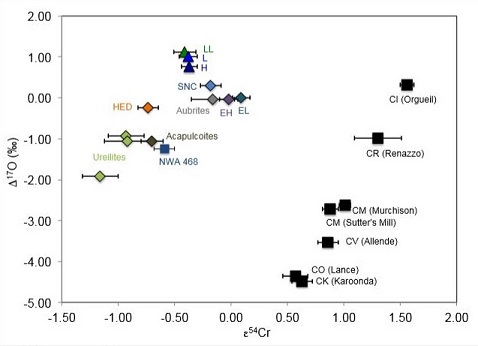
Diagram credit: Sanborn
et al., 77th Meteoritical Society Meeting
#5169 (2014) In their study of the
fossil meteoriteThe textural, mineralogical or compositional remnant within a sedimentary rock of a meteorite that fell millions of years ago and found in Ordovician limestone from Sweden. Read Tiny Traces of a Big Asteroid Breakup for a complete writeup on this subject. In picture to the left a nautiloid shell is Click on Term to Read More Österplana 065, Schmitz
et al. (2016) included oxygen and chromium isotopic data for NWA 468 in a coupled Δ
17O
vs. ε
54Cr diagram (shown below). This higher resolution diagram also clearly demonstrates that this meteorite plots within the acapulcoite–lodranite region in isotope space. Chromium
vs. Oxygen Isotope Plot
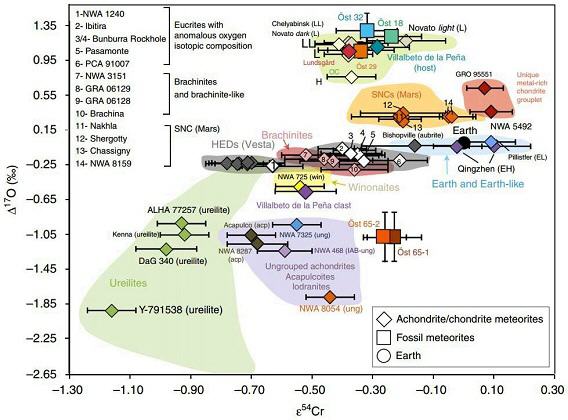 click on image for a magnified view
click on image for a magnified view
Diagram credit: Schmitz, B.
et al.,
Nature Communications, vol. 7, p. 4 (2016,
open access link)
‘A new type of solar-system material recovered from Ordovician marine limestoneA common form of calcium carbonate (CaCO3). Other common forms of CaCO3 include chalk and marble. Click on Term to Read More ‘
(https://doi.org/10.1038/ncomms11851) A comprehensive study of the H4 chondrite Grove Mountains (GRV) 020043 was conducted by Li
et al. (2018). They demonstrated that the mineralogy, geochemistry, and O- and Cr-isotopic compositions of this meteorite support the reclassification to ‘
Acapulcoite chondrite’, representing the chondritic, unmelted, outermost layer of the acapulcoite–lodranite parent body. They also provided clear evidence for the origination of NWA 468 on the ACA–LOD parent body, which, along with the metal-rich lodranite GRA 95209 (NASA
lab photo), are considered to represent the deepest lithology (early
coreIn the context of planetary formation, the core is the central region of a large differentiated asteroid, planet or moon and made up of denser materials than the surrounding mantle and crust. For example, the cores of the Earth, the terrestrial planets and differentiated asteroids are rich in metallic iron-nickel. Click on Term to Read More segregation) of the parent body. A schematic representation of the acapulcoite–lodranite parent body was presented by Li
et al. (2018):
Interior Structure of the Acapulcoite–Lodranite Parent Body 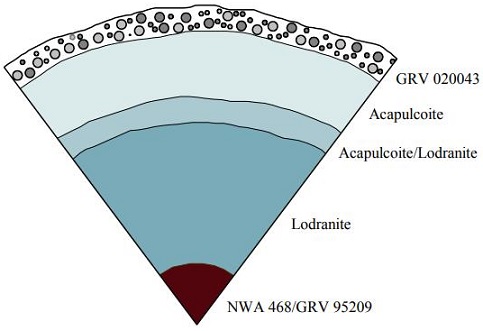
Schematic diagram credit: Li
et al.,
GCA, vol. 242, p. 96 (2018)
‘Evidence for a Multilayered Internal Structure of the Chondritic Acapulcoite–Lodranite Parent Asteroid’
(https://doi.org/10.1016/j.gca.2018.09.004) The specimen of NWA 468 shown above is a 2.45 g partial slice. The photo below shows a full slice with a close-up of the lower left corner from which the above specimen was removed. The remainder of this slice is in the collection of UCLA.
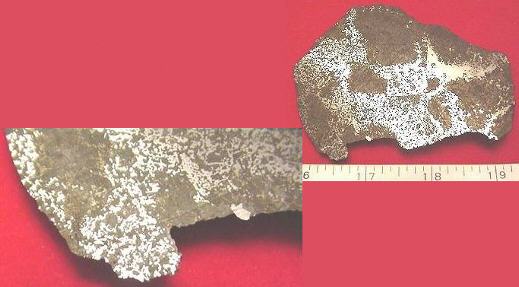
Photos courtesy of Dr. David Gregory












